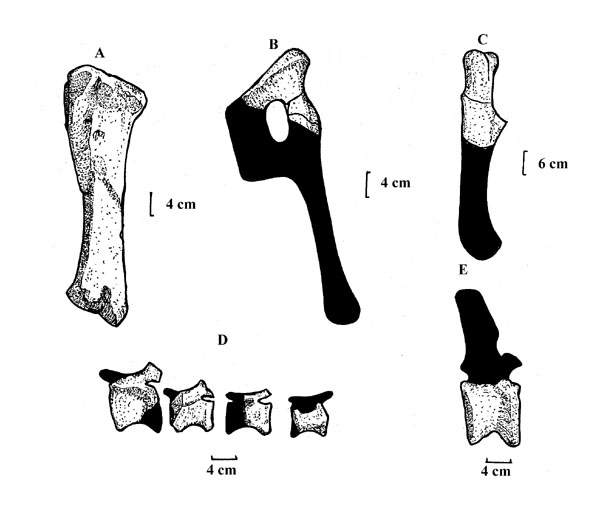
Genus: Eucnemesaurus HOEPEN, 1920
Etymology: Greek, eu- “good, true”, Greek, kneme “tibia, lower
leg”, and Greek, sauros, "lizard": Good tibia lizard”.
= Aliwalia GALTON, 1985
Etymology: Latinization of the Locality named Aliwal North in South Africa.
Species: fortis HOEPEN, 1920 (nomen
dubium)
Etymology: Latin, fortis, "strong."
Holotype: TM 119
Locality: Farm Zonderhout, near the railway station of Slabberts, (?)28'30"S, 28'14T, Fouriesburg District, Free (Orange Free) State, South Africa.
Horizon: ?Lower Elliot Formation.
Biostratigraphy: Euskelosaurus Range Zone
Age: Late Carnian or Early Norian Stage, Upper Late Triassic Epoch, Late Triassic.
Material: Proximal half of a femur (C), a complete tibia (A), a proximal portion of a pubis (B), portions of dorsal (E), caudal vertebrae (D) and some fragments.

Referred material:
YATES, 2005, 2007
Locality: Spioenkop, Heelbo farms, Rosendal District, Free State, South Africa.
Horizon: Lower Elliot Formation.
Biostratigraphy: Euskelosaurus Range Zone
Age: Late Carnian or Early Norian Stage, Upper Late Triassic Epoch, Late Triassic.
Material:
BP/1/6107: Left coracoid.
BP/1/6110: Distal end of a right femur.
BP/1/6111: Distal end of a right femur.
BP/1/6112: 2 rib shaft fragments.
BP/1/6113: A ventral fragment of a left scapula.
BP/1/6114: A fragment of the dorsal end of a left scapula?
BP/1/6115: A proximal caudal vertebra.
BP/1/6220: Fragments of a right proximal femur.
Several weathered bones were covered downstream from this site; fragmentary mid and dorsal caudal vertebrae and 2 phalanx phalanges.
BLACKBEARD, 2009
BP/1/6234: Posterior end of a skeleton and includes a number of thoric vertebrae, ilia, ischia, pubes, hind limbs and some poorly preserved caudal vertebrae.
= Aliwalia rex GALTON, 1985
Etymology: Latin, rex, "King."Holotype: NMW 1886-XV-39, proximal end of left femur and NMW 1876-VII B124: Distal end of left femur.
Locality: Barnard's Spruit, Ward, 24 km south of Aliwal North, Eastern Cape Province, Karroo Basin, South Africa.
Horizon: Assumed to be Lower Elliot Formation.
Biostratigraphy: Euskelosaurus Range Zone
Age: Late Carnian or Early Norian Stage, Upper Late Triassic Epoch, Late Triassic.
Referred material:
GALTON & HEERDEN, 1998
BMNH R3301: Left maxilla and premaxilla, with some replacement teeth.
Note: Aliwalia was referred to the Herrerasauridae by GALTON, 1985, but later moved to Dinosauria incertae sedis by GALTON & HEERDEN, 1998
_____________________________________________________________________________________
Species: entaxonis McPHEE, CHOINIERE, YATES & VIGLIETTI, 2015
Etymology: The novel species name alludes to the surprisingly robut foot architecture of this species. An entaxonic pes (or manus) is one in which the medial digis bear the main weight-resisting forces adn are thus the most developed-a trait later developed i the extreme within Sauropoda.
Holotype: BP/1/634
Locality: Cannon Rock Farm (owned by Piet Prinsloo), Aliwal North, Eastern Cape Province, South Africa.
Material: Lower Elliot Formation.
Biostratigraphy:
Age: Mid-Norian-Rhaetian Stage, Late Triassic Epoch, Late Triassic.
Material: Articulated remains of most of the hindquarters of a medium-sized sauropodomorph dinosaur consisting of articulated vertebral column composed of the posterior-most dorsal vertebrae, sacral vertebrae, anterior portionof tail, partial right ilium, partial pubic apron, left ischium, right femur and fragmetns of the left, distal epipodium (crus), and almost complete right pes.